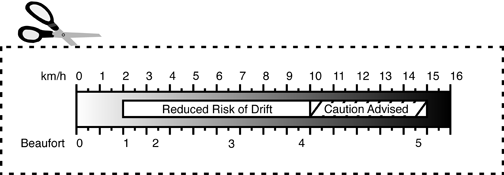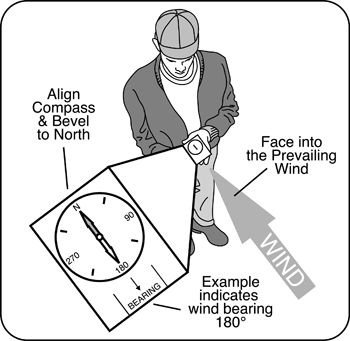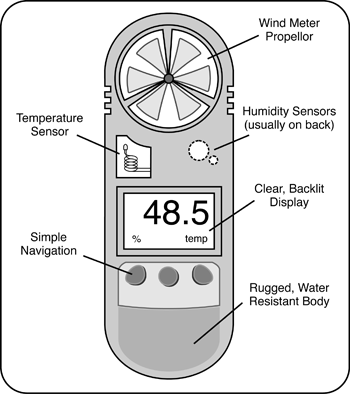How weather conditions affect spray applications
Learn about the impact of weather conditions on spray applications and how to change application methods to match weather conditions, improve accuracy and reduce wastage.
Introduction
Weather conditions such as wind, temperature, relative humidity and precipitation influence the effectiveness of spray applications and the potential for wastage by run-off and drift. This Factsheet describes the impact of weather conditions on spray applications and how to change application methods to match weather conditions, improve accuracy and reduce wastage. It also describes how to use simple tools to measure and monitor weather conditions and provides information on where to purchase these tools.
Wind
Wind direction determines whether droplets travel toward the target or toward unintended downwind areas such as open water, sensitive crops or areas of human activity. Wind speed affects the distance a droplet will travel before it is deposited on the target.
- Spray only when wind direction is consistent and between 2–15 km/h, or as indicated on the product label.
- The impact of wind is particularly significant when performing directed (e.g. airblast) spraying, so spray with a crosswind and always orient nozzles and deflectors to direct the spray into canopies, not over them.
Table 1, Wind conditions and spraying recommendations, describes various wind conditions and the potential for drift and advises whether or not to spray. Figure 1 shows the wind speed or force at which there is reduced risk of drift and the wind speed or force at which caution is advised. Cut out this scale and carry it in the spray cab for quick and easy reference.
Spray can be applied at the high end of this scale by using:
- drift-mitigating nozzles
- larger droplets
- slower forward speeds
- shrouds or deflectors and/or
- by reducing the distance to the target.
Temperature and relative humidity
- Spray when temperatures are low and relative humidity is high. In general, do not spray when relative humidity is less than 40 per cent and air temperature is above 25°C. This reduces the chance of drift due to temperature inversions or evaporation. It also increases target deposition and coverage.
- Hot and dry conditions increase drift because droplets rapidly evaporate and become fine droplets, vapour or particles of concentrated pesticide. Few countries specify optimal temperature or relative humidity because several other factors affect drift and on-target deposition. These factors include formulation, spray method, and droplet size.
- Optimum spraying conditions are early mornings following overcast nights. However, the best time to spray to avoid disrupting bee activity is evening or at night.
| Wind condition | Description | Wind speed / Beaufort at boom-height | Visible signs | Spraying |
|---|---|---|---|---|
| Still | May lead to vapour drift where finer droplets remain suspended in the air, prone to evaporation and drift long after spraying is completed | 0–2 km/h Force 0 | Smoke rises vertically | Do not spray |
| Gusty | These conditions make wind direction unpredictable and may indicate an inversion | Not applicable | Direction keeps changing | Do not spray |
| Light air | Suitable conditions | 2–3.2 km/h Force 1 | Direction shown by smoke | Spray |
| Light to gentle breeze | Ideal conditions | 3.2–9.6 km/h Force 2–3 | Leaves rustle, wind felt on face, twigs in motion | Spray |
| High | Higher wind speeds pose the most obvious risk of drift through, around or over target | 9.6–14.5 km/h Force 4 | Small branches move, raises dust | Spray with caution or Do not spray |

Precipitation
Rain can have both a positive or negative effect on spraying. Some products work best when rain water carries them into the soil after application, but not far enough to enter the water table before they do their work and break down. Depending on the rain-fastness of the product, rain soon after application may also wash the product from leaves and reduce the level of protection. While rain can also redistribute certain products over the target, do not rely on this for distribution.
- Monitor weather forecasts and understand the impact on the product being applied.
- Avoid spraying when foliage is still wet from rain or dew unless indicated by the label. A leaf can retain only a limited volume of spray, and therefore a limited amount of product.
- Once wetted, deposition will not increase beyond the tank concentration and the surplus will run off to the lower leaves and onto the soil.
Measuring weather conditions
Measure weather conditions when planning to spray, or during spraying if a change in conditions is suspected. Limitations on application temperature and wind speed may be on the pesticide label. Weather Innovations Incorporated (WIN) now offers an online spray advisory forecast for boom sprayers in Ontario at www.weathercentral.ca. This information is a prediction based on wind speed and is therefore only one factor in the decision to spray or not to spray.
It is the responsibility of all applicators to monitor and record local conditions using a combination of weather forecasts, a standard compass or windsock, and a fixed or handheld weather station.

Handheld weather station
A handheld weather station is an option for measuring temperature, relative humidity and wind speed.
- To measure temperature or relative humidity, take readings in the shade and wait a minimum of 15 seconds for accurate readings.
- To measure wind speed, hold the meter 1.5 m above the ground or the height of the spray boom, whichever is greater.
- Depending on the fullness of the canopy, wind speed is higher at the outer rows and the top of an orchard or vineyard canopy, so use a pole to lift the meter to canopy height and then check the recorded average.
- Monitor wind speeds over 2–3 minutes to determine the maximum and average wind speed and direction.
- Use a basic orienteering compass to determine prevalent wind direction.
- Step away from the sprayer, face square into the wind, and hold the compass level at waist height. (See Figure 2).
- Turn the whole compass so that the arrow in the centre of the base is facing away from you (into the wind). Turn the bezel, the rotating ring surrounding the compass face, until the "N" is centred over the north (red) end of the compass needle.
- Read the bearing of the wind, which is in degrees, from the circular scale directly over the centreline of the compass. The bearing is a value between 0 and 360 degrees.
Sourcing a handheld weather station
At the time of publication, the average price of a handheld weather station is about $175, but the price varies depending on the features required. Features to look for include a durable body, a hard case and lanyard, a backlit display and the ability to measure wind speed, relative humidity and temperature (see Figure 3). Retailers are listed in Table 2, Sourcing handheld weather stations.

| Company | Phone |
|---|---|
| Green Lea Ag. Center | |
| Graham Agriservices | |
| HJV Equipment Ltd. | |
| Phillips Farm Supplies | |
| Commercial Solutions | |
| Forestry Suppliers Inc. | |
| Haltech Environmental | |
| Hoskins Scientific |
No discrimination is intended and no endorsement by the author or OMAFRA is implied. Information subject to change.
Conclusion
When planning to spray, consider local forecasts and consult the label for product specifications such as optimal application conditions, drying time, absorption rate and retention time. Use a handheld weather station to adapt your application method to changing weather conditions. If conditions become too adverse it is sometimes necessary to stop spraying until they improve. You can't change the weather, but with accurate information you can work with it to achieve the best results.